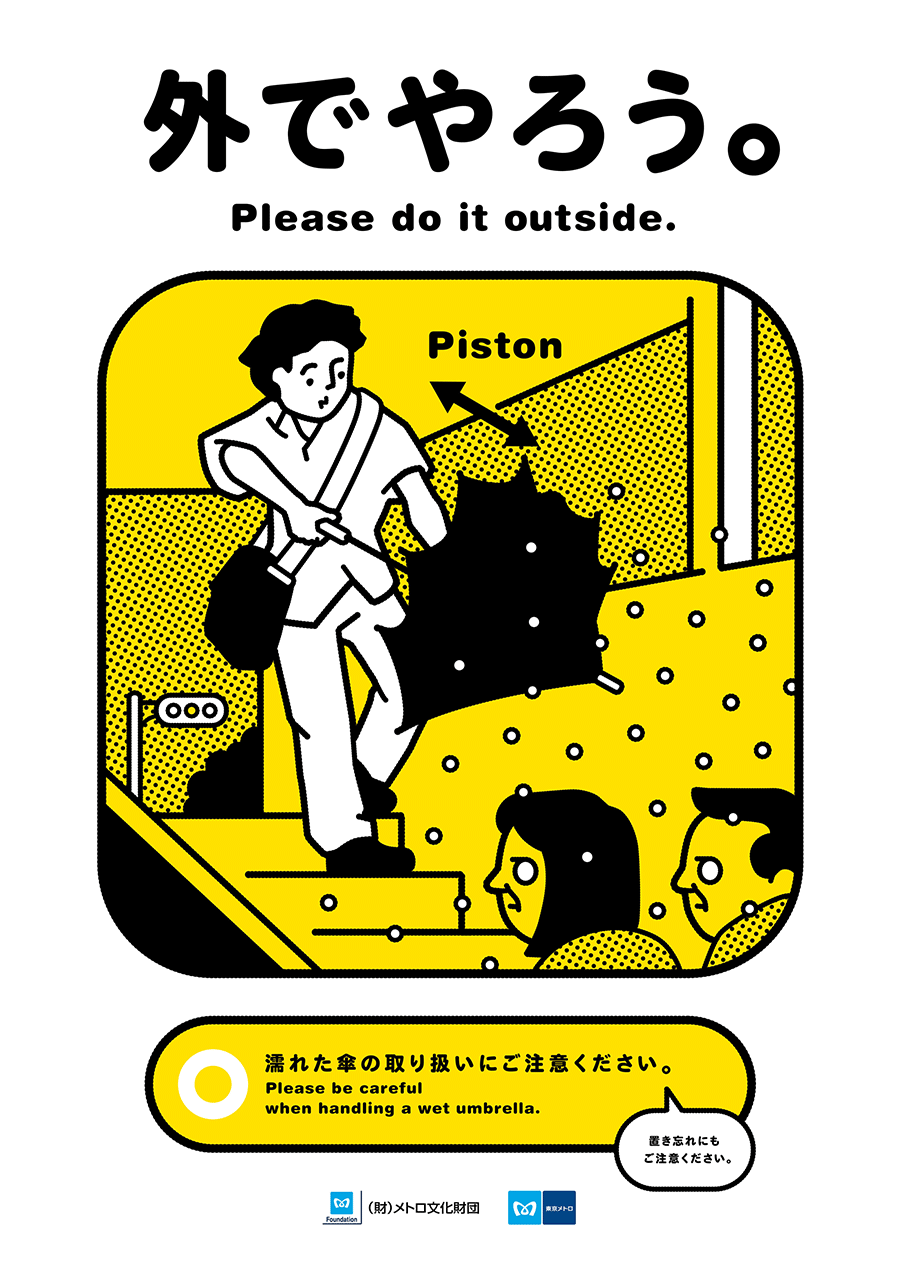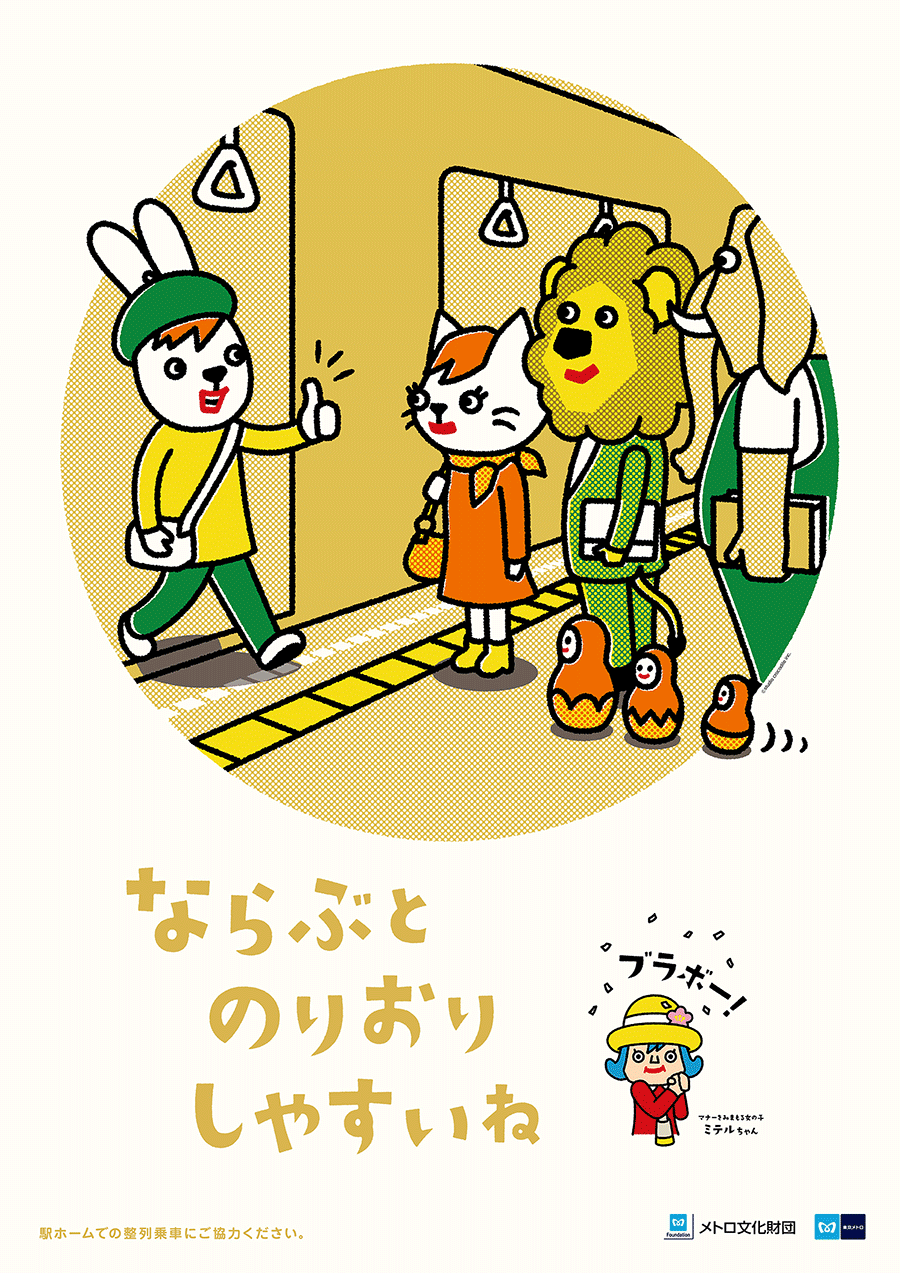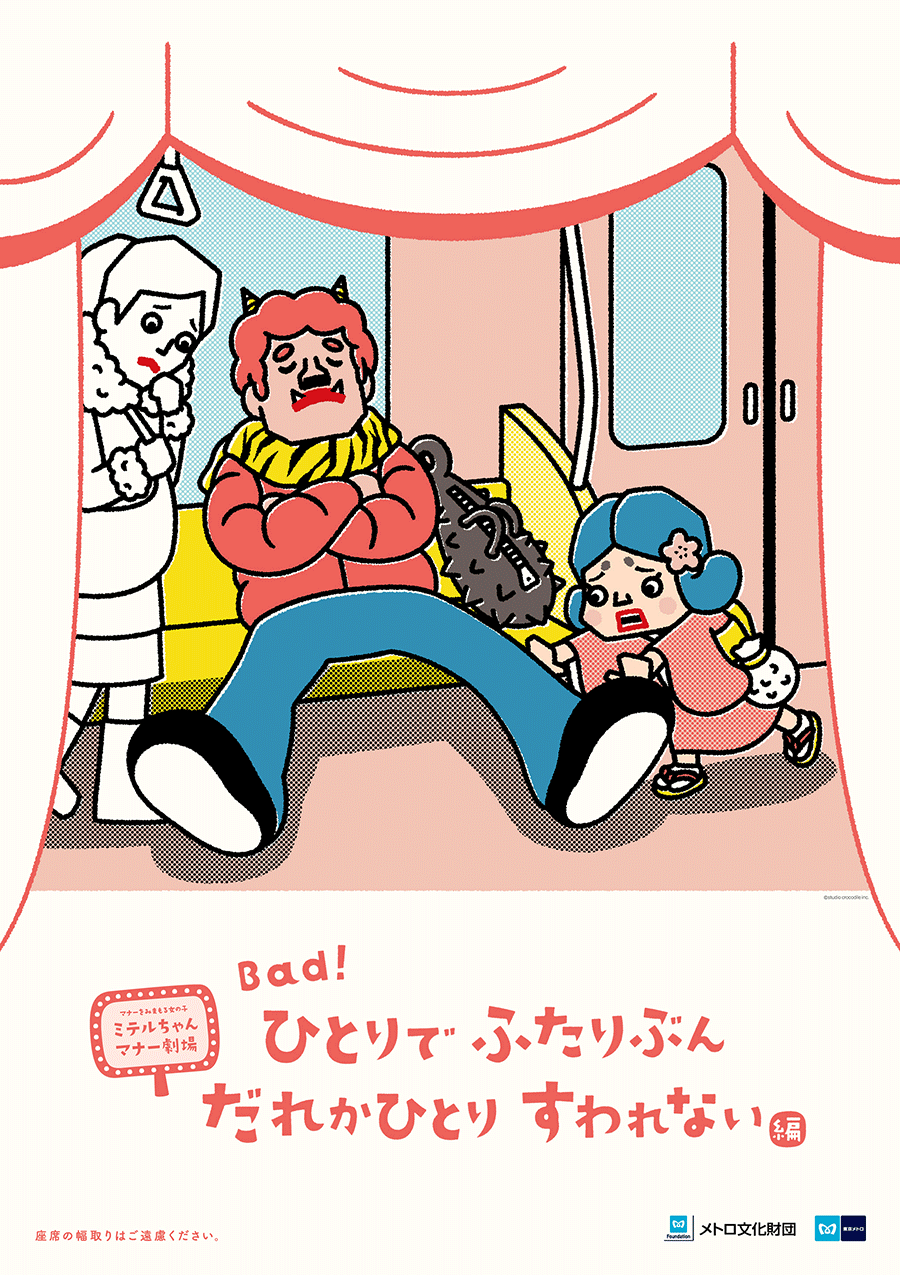Social Control or Trust? A Journey through Tokyo’s Railway Manner Posters
During my long stay in Japan, the ‘manner posters’ displayed along the corridors and platforms of railway stations in Tokyo were a common sight. Through graphical content and accompanying text in these posters instruct passengers on social etiquette and public decency in railway spaces.
Many railway companies in Tokyo (i.e., Tokyo Metro, Seibu Group, Keio) have a long-established tradition of displaying manner posters. These address different audiences and situations, and they construct normative standards of behaviour in public spaces. These manner posters have a strong visual component – specifically, the posters’ images are more expressive than their textual contents. In this article, I examine several recent eye-catching manner posters displayed by Tokyo Metro and argue that, rather than nannying or controlling, these posters play a more progressive role. By collectively constructing a shared value system among daily commuters of busy railway lines in Tokyo, these posters underpin mutual trust among passengers.
Japanese public etiquette on rails, roads, and beyond
Historical evidence of Japanese ‘conduct literature’ dates back to the Tokugawa period (1600-1868) with the advent of commercial print culture. 1 Illustrated, easy-to-read “how-to” books were commonplace in Tokugawa Japan, and Ikegami identifies these books as “Tokugawa books of civilized knowledge.” 2 Some of the commonplace labels were “chōhōki/重宝記(treasure books, manuals); setsuyō-shū/節用集 (dictionaries, often encyclopedic); kinmō zui/訓蒙図彙 (illustrated encyclopedias written at the introductory level); shorei-shū/諸礼集 (guidebooks for formal manners); shosatsu-shū/書札集 (correspondence guidebooks); and ōrai mono/往来物 (collections of model correspondence used as elementary school textbooks).” 3 The body and its relationship to social status were central concerns: some handbooks highlighted the rules for bowing, fan etiquette, clearing the nasal passages, passing a sword to another person, serving drinks and food, table manners, and sliding doors. Ikegami also notes that these Japanese manners and etiquette have been strongly influenced by the performing artists in Japan who “generally attempt to shape a body capable of the graceful execution of stylized movement through practiced repetition of motions and gestures.” 4
Concerns about good manners in public transport in Japan manifested in various visual and non-visual forms. For instance, in 1924, the Asahi newspaper reported about the increased number of cases of cheating on the fare ticket. "5 In 1911, a male reader wrote to the Yomiuri newspaper that “rules should be enacted regarding the proper way to sit in mass transit vehicles. He advocated that passengers be forbidden from sitting with their legs extended or open and from taking up more space than is needed by one person.” 6 Newspapers reported negatively on the behaviours of schoolgirls and young women on mass transportation in the first decade of the 20th century, expressing concern over the deterioration of public manners. 7 This discourse on female misconduct continues to the present, as some Japanese criticize the way females apply cosmetics/makeup on trains. In one of Tokyo Metro’s recent manner poster campaigns, entitled “Please Do it at Home,” a female applying makeup is portrayed as running counter to public etiquette. 8

Fig. 1: A poster on how to handle your wet umbrella in public space, 2009. (Photo copyright: Tokyo Metro. Reprinted with permission).
While the above are non-visual accounts of expected manners, during the Taisho period (1912-26), The Dictionary of Meiji and Taisho Period Etiquette and Manners (絵で見る 明治・大正礼儀作法事典) published illustrated etiquette for short commutes and long-distance train travel for youth, 9 perhaps one of the first instances of visualized train etiquette in Japan. George Bigot (1860-1972) also illustrated some of the manners of the Japanese on railroads, especially the way passengers relax in second-class compartments. 10 Photographs of how people queued up for crowded streetcars in 1920 are available in the Transportation Museum.
Contemporary manner posters
Many railway companies in Tokyo currently promote public manners and etiquette in commuting. The largest railway operators in Tokyo – Keio, Tokyo Metro, JR East Japan Railway Company, and Seibu – have all adopted various programmes to promote manners of public commuting. Tokyo Metro was one of the pioneers, launching a manner poster campaign in September 1974. The tradition continues today, and each year the subway company adopts a particular theme for its manner posters (e.g., “Do it somewhere else” in 2008, “Good manners, Good Tokyo” in 2018). Every month a new poster is displayed on its platform walls, at automatic ticket gates, and along station corridors.
The manner posters cover a range of topics. For instance, loud talking, eating, talking on the phone, holding parties, unnecessarily invading the seating space, drinking and sleeping, blocking the entry/exit, rushing to board trains, and applying cosmetics/make-up are some of the discouraged activities inside trains. Helping others, offering seats to the elderly, lining up for boarding, properly storing luggage on racks, and properly handling large luggage are some of the encouraged activities. Interestingly, some manner posters target subtle human behaviours like “how to handle your wet umbrella in public space.” Other posters, negatively depicting a couple’s intimacy inside a train, indicate what is considered ‘private’ and ‘public’ in Japan. The majority of these visual contents are highly expressive, cynical, and humorous.

Fig. 2: A poster encouraging passengers to line up before boarding, 2014. (Photo copyright: Tokyo Metro. Reprinted with permission).
The visual content of these manner posters overwhelms the textual. The instructions for good manners have been visualized. The textual contents, in many of the cases, have been given a relatively lower emphasis or priority. The “images, not the text [in the manner posters], are the core of the communication. In one glance they tell the story.” 11 Scholars who analyze visual artifacts agree that, compared to verbal cues, images are more memorable, which makes the viewers process those faster than the textual contents. Previous research finds that the use of pictorials in warnings increases comprehension 12 and enhances the memory of a warning. 13
Notably, the railway manner posters in Japan are similar to other pictorial warings (i.e., signal words such as Danger, Warning, or Caution) commonplace in many countries, but they also differ in key respects. While commonplace signal words (along with pictorial signs) function to communicate safety-related information, the manner posters do not only convey safety warmings but also display a range of public etiquette and cover a wider range of situations inside trains and railway stations. Scholars also argue that the use of manner posters in Japan is substantially different from other parallels, such as the use of cartoon characters by the Paris Transport Authority (RATP). The anthropomorphic pink rabbit of the Paris RATP – portrayed with his left hand pinched between the sliding doors of a train – invites the passengers to pay attention to the automated device which closes the train entrance. However, the Japanese manner posters differ substantially in terms of their communicative aim. “They [manner posters] are not concerned with the passenger’s own safety, they do not want to warn him of the danger of dealing inattentively with a technological environment. They focus instead on person-to-person relationships, on the sensitivity of the other travellers, who might be hurt by our inconsiderate and self-centred behaviour.” 14

Fig. 3: A poster illustrating the ill-mannered way of sitting with widened legs, 2015. (Photo copyright: Tokyo Metro. Reprinted with permission).
Social control or social trust?
As a regular passenger of commuter trains in Tokyo, I became interested in what determines the efficiency, peacefulness, and user-friendliness of Japan’s rail transportation? Is it merely a product of modern technology and advanced transport ergonomics, or is there something more to it? In my opinion, while technology and the punctuality of train operators (companies) are impressive, what makes the Japanese railway system unique is its passengers and their shared behavioural standards inside spaces of public transport. While some scholars argue that these manner posters induce subtle social control by regulating the social life of passengers and placing them under the gaze of other passengers, I argue that these posters foster a sense of social solidarity and trust.
Manner posters collectively construct a shared value system among daily commuters of busy railway lines in Tokyo, which consequently yield mutual trust among passengers. This enables the passengers to associate with each other for a common purpose. It is important to note that the trust among commuters is not based on explicit rules and regulations but out of ethical habits and reciprocal moral obligations. This notion of trust has a larger and a measurable economic value, which needs to be explored in future research. In conclusion, the practice of displaying manner posters along the corridors and platforms of busy railway stations in Japan is best understood as a soft tool for forming a shared value system among the passengers, rather than a subtle instrument of social control.
Sandunika Hasangani is a Senior Lecturer at the Department of International Relations, University of Colombo, Sri Lanka. Email: sandunika@inr.cmb.ac.lk or sandunika.hasangani@gmail.com